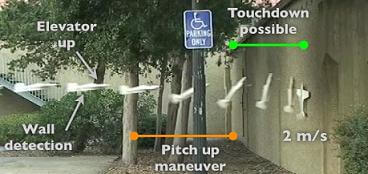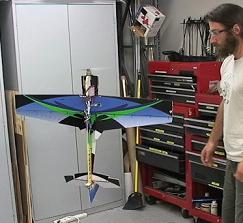Stanford’s latest unmanned aerial vehicle (UAV) can do something I’ve never seen before: land on and take off from a vertical surface. Using a range finder the model-sized automated plane determines how far it is from a wall. At the right distance an open source auto-pilot (Paparazzi) guides the vehicle into a breaking climb and then specially crafted gripping legs let it perch securely. You’ve got to see this thing in action, at times it seems much more like an insect than aircraft. Check it out in the video below.

The “Perching Project“, as the work is known, is just the latest from Stanford’s Biomimetics and Dexterous Manipulation Lab, the same group that brought you StickyBot, and RISE. These guys know how to get robots to cling to a wall. The biggest application for the perching plane seems to be urban spying. We’ve seen various futuristic spy drones before, even those that incorporate some biomimetic technology, but the perching plane vertical surface landing and take off give it some truly innovative functionality. Here’s how Stanford describes the scenario:
A flock of small, unmanned air vehicles flies quietly into a city, maneuvering among the buildings. They communicate as they search for places to land, not on streets or flat rooftops but on the sides of buildings and under the eaves, where they can cling, bat or insect-like, in safety and obscurity. Upon identifying landing sites, each flier turns toward a wall, executes an intentional stall and, as it begins to fall, attaches itself using feet equipped with miniature spines that engage small asperities on the surface. Using its propeller in combination with its limbs, the flier can creep along the wall and reorient for a better view. With opposed pairs of spines, the flier clings tenaciously to resist gusts of wind and ride out inclement weather. The fliers stay attached for hours or days, consuming little power and emitting no sound as they monitor the area. When finished, they launch themselves with a jump and become airborne again, ready for their next mission...[From Perching White Paper]
That sounds awesome. And it looks even better:
This video was made, in part, to showcase the history of the Perching Project for the latest ICRA. As such, we get a great glimpse into the development of the plane and its limitations. A lot depends on the proper calibration of the legs, the control of the auto-pilot, and the conditions near the wall. According to the project site, the plane can hover in a vertical stall fairly well, but the team is still working on improving the way it comes out of its wall take-off. Also, for all the talk of observation capabilities, such systems don’t seem to have been included on the plane yet. Hopefully, Stanford will be able to address each of these issues going forward. Judging by the white paper, various published articles, and the project website Stanford’s invested in getting this idea to come to full fruition.

If their vision from the white paper is to be achieved, however, they’ll have to reach a mass manufacturing level, and that’s likely to take years. I wonder, however, if the lab wouldn’t be open to sharing some of their prototype specs in an open format in the meantime. I’m sure the guys over at DIY Drones would love to experiment with making one of these, and most of the materials (besides the carbon fiber legs) seem to be in the range of dedicated hobbyists.
It’s much too early in this project to know what final shape the perching plane will take, or even if the system will be successful. Still, Stanford’s innovative legs are simple and robust enough to make them likely candidates for adoptions in other systems. No, we’ll probably never see a manned vehicle trying to perch on a wall, but I wouldn’t be surprised if developers of other spy UAVs start to consider how they might include vertical surface landings and take-offs. In the future, micro-UAVs may become a valuable part of military reconnaissance, police surveillance, or even child monitoring (You can go out and play, but make sure to take your drone with you). And with Stanford’s Perching Project, those vehicles will be able to go pretty much everywhere.
[image credits: Stanford University]
[sources: Stanford University’s PerchingProject, White Paper, Paper for ICRA 2010]


